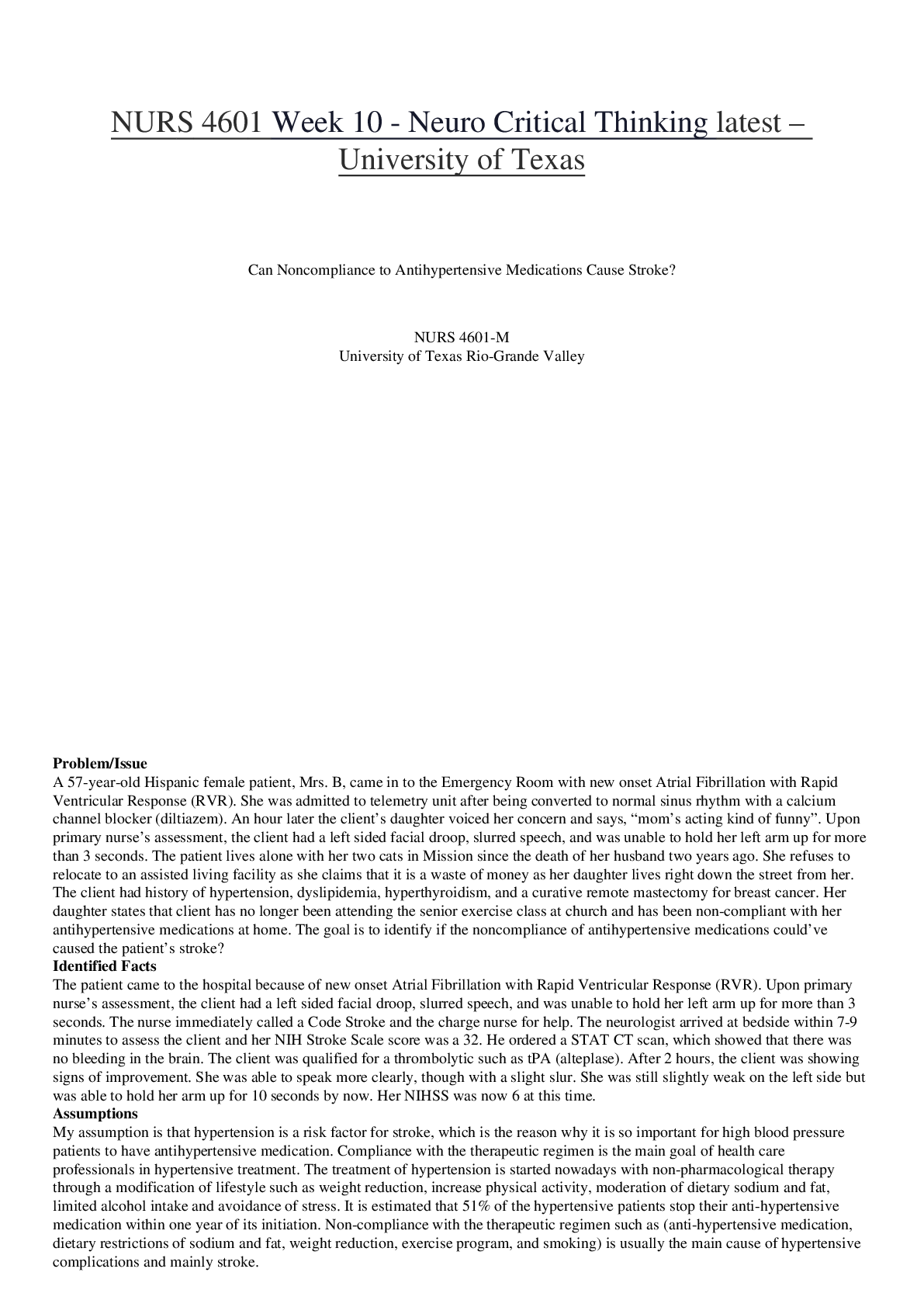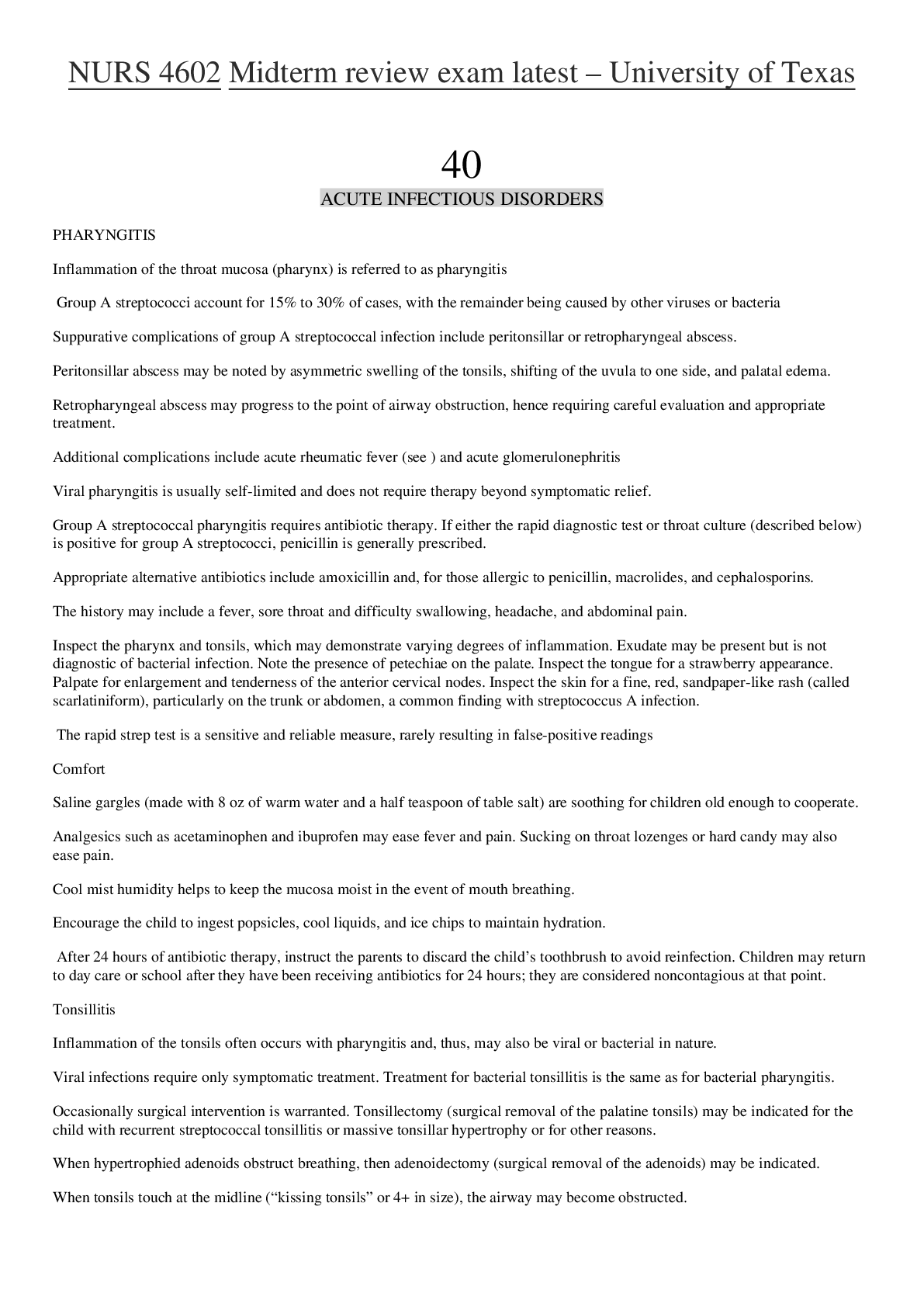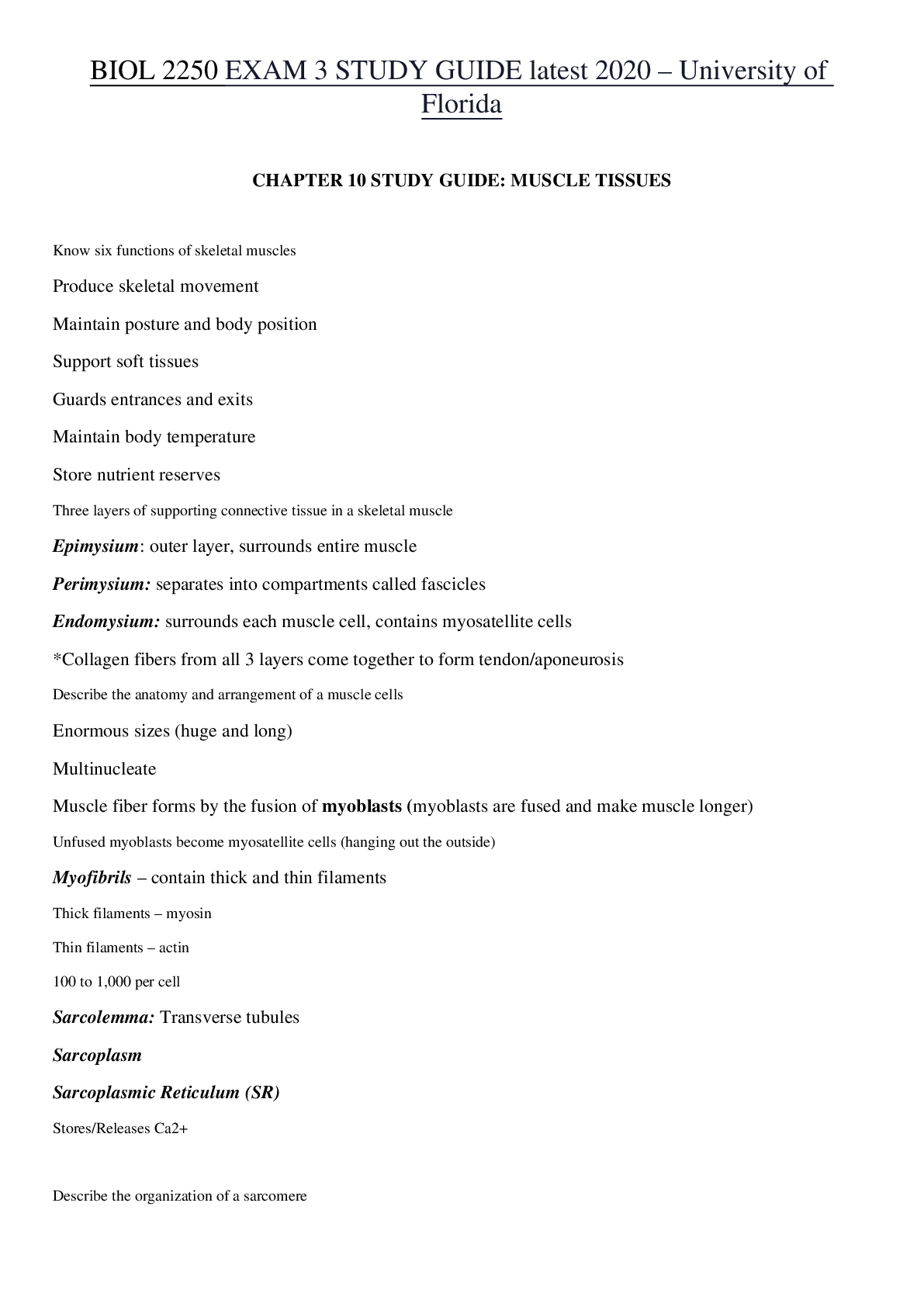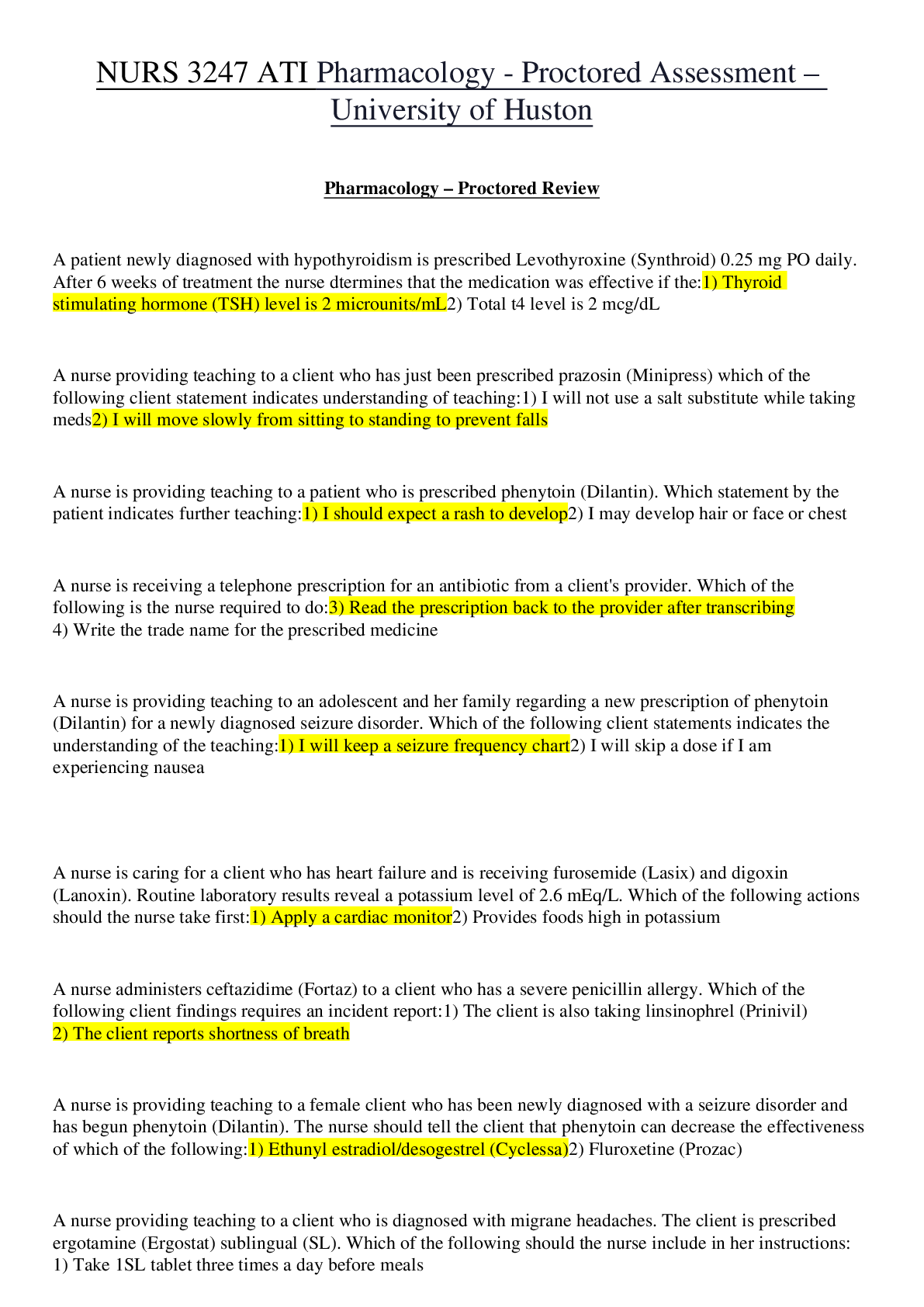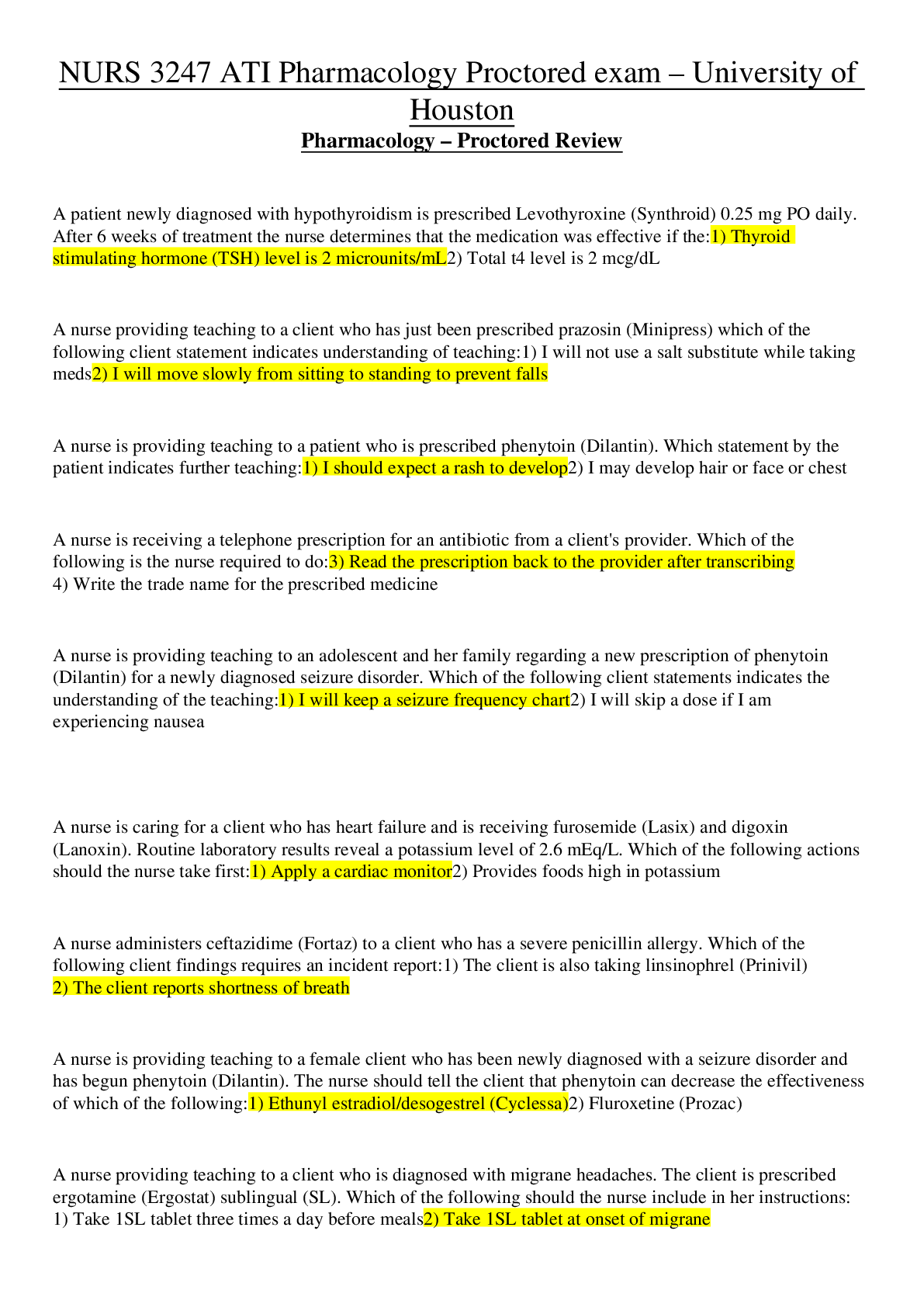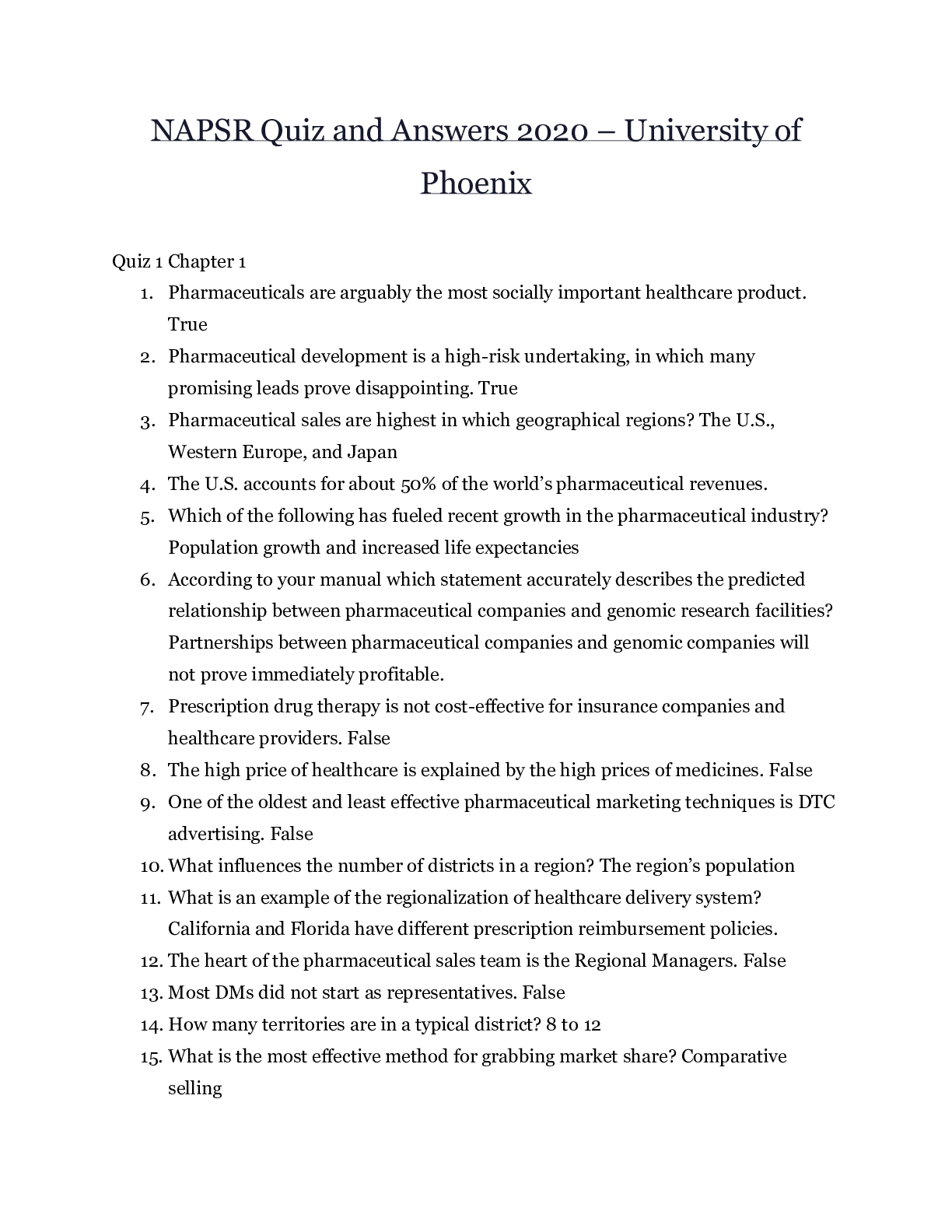Economics > EXAM > AP 100 ECON Study plan for Exam 2 – University of Washington | AP100 ECON Study plan for Exam 2 (All)
AP 100 ECON Study plan for Exam 2 – University of Washington | AP100 ECON Study plan for Exam 2
Document Content and Description Below
AP 100 ECON Study plan for Exam 2 – University of Washington The three major types of firms in the United States are called Limited liability means that The government grants limited liabilit... y to the owners of corporations Limited liability becomes more important for firms trying to raise funds from a large number of investors, rather than from a small number of investors, because What do we mean by the separation of ownership from control in large corporations? How is the separation of ownership from control related to the principal-agent problem? Suppose that shortly after graduating from college you decide to start your own business. Assuming you are starting a small business and want it to be your business a lone which category of firm are you most likely to start? An article discussing the reasons that the Connecticut state legislature passed a general incorporation law in 1873 observes that prior to the passage of the law, investors were afraid that large businesses "were not a safe bet for their money." The author argues that investors' fear was because prior to the passage of the law, I would like to invest in the stock market, but I think that buying shares of stock in a corporation is too risky. Suppose I buy $10,000 of Twitter stock, and the company ends up going bankrupt. Because as a stockholder, I'm part owner of the company, I might be responsible for paying hundreds of thousands of dollars of the company's debts. This statement is: "Family-run companies ... could not raise sufficient capital to exploit the large-scale opportunities tied to the rise of the steam engine, notably railways and (with limited exceptions) global shipping and automated manufacturing." How did the United States solve the problem of firms raising enough funds to operate railroads and other large-scale businesses? To help firms raise enough funds to operate railroads and other large-scale businesses, the United States Two economists at the Brookings Institution argue that "new firms rather than existing ones have accounted for a disproportionate share of disruptive and thus highly productivity enhancing innovations in the past—the automobile, the airplane, the computer and personal computer, air conditioning, and Internet search, to name just a few." New firms might be more likely than older firms to introduce "disruptive" innovations because new firms May find it difficult to compete with the same types of goods and services already being produced by the larger, established firms Assuming these economists are correct about the most important source of productivity enhancing innovations, the declining trend in the formation of new businesses implies that The U.S. economy will become less dynamic and less able to sustain high rates of economic growth An Associated Press article noted that some groups have filed lawsuits over what the groups describe as "overzealous licensing schemes, in occupations such as hair braiders, yoga teachers and casket makers." Government licensing requirements would cause the rate of new businesses being formed to decrease Given your answer to part (a), state and local governments pass these type of licensing requirements because They are designed to insure the quality of service providers The principal-agent problem arises almost everywhere in the business world—but it also crops up even closer to home, such as the case of the college classroom. In this case, who is the principal and who is the agent? The principal is the student and the agent is the professor . The principal-agent problem in the public corporation between ownership and top management results from asymmetric information. All of the following are correct, except This principal-agent problem can be prevented or reduced if the managers are allowed to have freedom in running the company Sales personnel, whether selling life insurance, automobiles, or pharmaceuticals, typically get paid on commission instead of a straight hourly wage. The principal-agent problem between the owner of the business and its sales force is Reduced when workers are paid on commission because it gives them an incentive to work harder Private equity firms, such as Blackstone and Kohlberg Kravis Roberts & Co., search for firms where the managers appear not to be maximizing profits. A private equity firm can buy stock in these firms and have its employees elected to the firms' board of directors and may even acquire control of the targeted firm and replace the top management. Do private equity firms improve corporate governance? Yes, private equity firms replace poorly performing managers with shareholder-friendly managers For which of the following types of business organizations is there a legal distinction between the personal assets of the owners of the firm and the assets of the firm? There is no limit to your liability In the United States, ________ account for the majority of revenue earned and ________ account for the majority of business organizations. Corporations; sole proprietorships What term do economists use to refer to the conflict between the interests of shareholders and the interests of top management? A principal-agent problem Direct finance is borrowing via financial markets, while indirect finance is borrowing from financial intermediaries. If you borrow money from a bank to buy a new car, you are using indirect finance A bond represents a loan to the company, while a share of stock represents part ownership of the company . The stock and bond markets provide information to businesses through changes in prices. A decrease in the price of a firm's stock would tell managers which of the following? Investors expect the firm to have lower profits in the future A decrease in the price of a firm's bonds would tell managers which of the following? The cost of external funds has increased. Suppose that a firm in which you have invested is making a lot of moneymaking a lot of money. Would you rather own the firm's stock or the firm's bonds? Stock If losing a lot of money: bonds Suppose you originally invested in a firm when it was large and profitable. Now the firm has downsized and is small and unprofitable. Would you be better off now if you had bought the firm's stock or the firm's bonds? Bonds If you deposit $20,000 in a savings account at a bank, you might earn 3 percent interest per year. Someone who borrows $20,000 from a bank to buy a new car might have to pay an interest rate of 8 percent per year on the loan. Knowing this, why don't you just lend your money directly to the car buyer, cutting out the bank? Since you would be loaning all of your savings to one borrower, it would be extremely risky The shares of stock issued as a result of Twitter's Initial Public Offering (IPO) were sold in a primary market. The IPO is an example of direct finance. According to an article in the Wall Street Journal, in May 2015, Moody's Investors Service cuts its rating on McDonald's bonds from A3 to A2. Source: Chelsey Dulaney, "Moody's Downgrades McDonald's, Following S&P and Fitch," Wall Street Journal, May 15, 2015. What is Moody's top bond rating? Aaa Under what circumstances would Moody's, or the other bond rating agencies, be likely to cut the rating on a firm's bonds? None of the above The likely result of this rating's cut will be McDonald's will have to pay a higher interest rate when it sells bonds Moody's, S&P and Fitch don't sell their services directly to investors because they argue that Doing so creates a "free rider" problem What impact would each of the following events be likely to have on the price of Google's stock? A competitor launches a search engine that is just as good as Google's. State whether the following statement is true or false: "The total value of the shares of Microsoft stock traded on the NASDAQ last week was $250 million, so the firm actually received more revenue from stock sales than from selling software." The statement is false because Microsoft does not receive the money investors paid for the stock A column in the Wall Street Journal titled "Three Mistakes Investors Keep Making Again and Again" listed "trying to forecast what stocks will do next" as one of the three mistakes. Trying to forecast stock prices would be a mistake for the average investor because Stock prices are based on expected future profitability, which is very unpredictable In a letter to his company's stockholders, Warren Buffett offered the following opinion: "Most investors, of course, have not made the study of business prospects a priority in their lives... I have good news for these non-professionals: The typical investor doesn't need this skill." Warren Buffet is advising non-professional investors to Concentrate on buying shares of mutual funds that charge relatively low fees Stocks are financial securities that represent partial ownership of a firm. Three of the most widely followed stock indexes are the Dow Jones Industrial Average, theS&P 500, and the NASDAQ. Which of the following does not describe the general movements of these three stock indexes? Stock prices decreased during the expansion of the late 1990s Which of the following terms refers to a flow of funds from savers to firms through financial markets? Direct finance The payments by a corporation to its shareholders are called ________, and the interest payments on a bond are called ________. Dividends; coupon payments An increase in a firm's stock price most likely indicates which of the following? Optimism about the firm's profit prospects If the price of a firm's bonds decreases, this indicates A higher cost of new external funds Which of the following stock indexes experienced a sharp decline in late 2007, reflecting the severity of the recession, which began late that year? All of the above An asset is something that the company owns, and a liability is anything that the company owes An example of an asset would be plant and equipment, while an example of a liability would be a bond that the company has issued A balance sheet shows the firm's overall financial position at some point in time, while an income statement shows the firm's revenues, costs, and profits at some point in time. A firm's explicit cost is its monetary cost whereas its implicit cost is its nonmonetary opportunity cost All of the following statements are true, except A firm maximizes profit when total cost equals total revenue. Suppose a business earned a positive accounting profit, but a negative economic profit, then It will be very unlikely for the firm to remain in business in the long run Paolo currently has $100,000 invested in bonds that earn him 10 percent interest per year. He wants to open a pizza restaurant and is considering either selling the bonds and using the $100,000 to start his restaurant or borrowing the $100,000 from the bank, which would charge him an annual rate of interest of 7 percent. He finally decides to sell the bonds and not take out the bank loan. He reasons, "Because I already have the $100,000 invested in the bonds, I don't have to pay anything to use the money. If I take out a bank loan, I will have to pay interest so my costs of producing pizza will be higher if I take out the loan than if I sell thebonds." Paolo's reasoning is Incorrect because the bank's rate of interest is less than the amount that he is earning on his savings Paolo and Alfredo are twins who both want to open pizza restaurants. Because their parents always liked Alfredo best, they buy two pizza ovens and give both to him.Unfortunately, Paolo must buy his own pizza ovens. Does Alfredo have a lower cost of producing pizza than Paolo does because Alfredo received his pizza ovens as a gift while Paolo had to pay for his? No, Alfredo's cost is equal to Paulo's cost because the opportunity cost of the ovens is the same as what Paulo must pay Assuming that Paolo buys identical ovens, and that otherwise the two pizza restaurants are exactly the same and have exactly the same revenues, which of the following is true? Alfredo has higher accounting profits than Paolo, but their economic profits are the same a. How much is Dane's economic profit for the year? −$66000- Interest forgone on the $900,000 extraterrestrial gear b. Is he earning an accounting profit? Yes, he is earning an accounting profit Twitter was founded in 2006, but it wasn't until 2013 that Twitter filed its first annual report with the Securities and Exchange Commission (SEC). Briefly explain why. Annual reports are only required of: Public companies, and before 2013 Twitter was a private company Jay Ritter, a professor at the University of Florida, was quoted in the Wall Street Journal as saying about Facebook: "It's entirely possible for a company to have solid growth prospects while its stock is overvalued." A stock is considered to be overvalued when: the current stock price is not supported by earnings fundamentals A firm's stock may be overvalued despite the firm having "solid growth prospects" because of Exaggerated growth prospects, or an emotional buying spike Which of the following terms shows a firm's revenues, costs, and profit over a period of time? The income statement What term do economists use to refer to the minimum amount that investors must earn on the funds they invest in a firm, expressed as a percentage of the amountinvested? The normal rate of return Which of the following statements is correct? Accounting profit is typically larger than economic profit What is a balance sheet? A summary of a firm's financial position on a particular day The Sarbanes-Oxley Act Requires that CEOs of corporations certify the accuracy of financial statements Requires that CEOs of corporations certify the accuracy of financial statements To promote management accountability in corporations What was the source of the problems encountered by many financial firms during the crisis of 2007minus−2009? During the crisis of 2007minus−2009 Many borrowers began to default on their mortgages OR the prices of home mortgages plunged The following is from an article in USA Today: In what some call a worldwide corporate-governance movement, shareholders are pushing for stronger corporate-governance laws, teaming with investors from different countries and negotiating behind the scenes with businesses. What is corporate governance? Corporate governance is: The way a corporation is structured and the effect of that structure on firm behavior Why would shareholders push for stronger corporate governance laws? Shareholders would push for stronger corporate governance laws so that top managers of corporations; Will have less ability to inflate profits According to an article in the Wall Street Journal: "Companies in Standard & Poor's 500 stock index elected the smallest number of new directors last year [2012] in 10 years ...." What is the possible negative of having long standing board members? Directors develop too cozy of a relationship with management which impairs their oversight function Michael Dell founded PCs Limited in 1984. The firm had an initial public offering (IPO) in 1988 under the name Dell Computer Corporation, which enabled the company to raise money it used for expansion. In 2013, Michael Dell and a private equity firm bought back ownership of the company from its shareholders. Dell is now a privately owned firm. Michael Dell was motivated to make this change because as a private company, Dell Can take a long-term view and not worry about short-term returns An article about corporate fraud on forbes.com stated that "misleading accounting and disclosure practices weaken the integrity of capital markets." The article noted that using incentive contracts for top managers can create a "'perverse' incentive to manipulate stock prices because their(executive) total package is based on stock price appreciation." Markets depend on accurate accounting and disclosure practices because Accurate information allows financial intermediaries to correctly assess the risk of lending, and properly determine the terms of lending Misleading accounting and disclosure practices can weaken the integrity of capital markets because: unreliable information would be used for decision making purposes, misallocating resources Corporate boards of directors sometimes link top managers' compensation to the corporations' stock prices in order to: Reduce the effect of the principal-agent problem Tying compensation too closely to stock prices can create an incentive for corporate fraud because: this gave top managers - - - - - - - - - - - - - - - - - - - - - - - - - - - - - - - - - - - His decision on what price to charge and how much to produce in the long run will be Based on optimal plant size determination based on cost minimization. Suppose that Comcast has a cable monopoly in Philadelphia. The following table gives Comcast's demand and costs per month for subscriptions to basic cable Suppose the local government imposes a $99 per month tax on cable companies. What will Comcast do? Comcast should produce 6 units in the short run and shut down in the long run. Suppose that the flat per-month tax is replaced with a tax on the firm of $4 per cable subscriber. To maximize profit, Comcast will sell 5 subscriptions and charge a price of $60 for profits of $76. Before inexpensive pocket calculators were developed, many science and engineering students used slide rules to make numeric calculations. Slide rules are no longer produced, which means nothing prevents you from establishing a monopoly in the slide rule market. The graph to the right shows the situation your slide rule firm would be in, with your demand, marginal revenue, average totalcost, and marginal cost curves. Does a monopolist have a supply curve? Briefly explain. (Hint: Look again at the definition of a supply curve in Chapter 3 and consider whether this applies to amonopolist.) A monopolist: does not have a supply curve because it is a price maker with one profit-maximizing price-quantity combination. A student argues, "If a monopolist finds a way of producing a good at lower cost, he will not lower his price. Because he is a monopolist, he will keep the price and the quantity the same and just increase his profit." Do you agree? According to your graph, when producing at lower cost, the profit-maximizing price is lower . When home builders construct a new housing development, they will usually sell the rights to lay cable to a single cable television company. As a result, anyone buying a home in that development is not able to choose between competing cable companies. Some cities have begun to ban such exclusive agreements. WilliamsTownship, Pennsylvania, decided to allow any cable company to lay cable in the utility trenches of new housing developments. The head of the township board of supervisors argued, "What I would like to see and do is give the consumers a choice. If there's no choice, then the price [of cable] is at the whim of the provider." In a situation in which the consumers in a housing development have only one cable company available, is the price really at the whim of the company? Would a company in this situation be likely to charge, say, $500 per month for basic cable services? Explain why or why not. A cable company in this situation: would not be free to charge any price it chooses because it would still be constrained by consumer demand Will a monopoly that maximizes profit also be maximizing revenue? Briefly explain. A monopoly that maximizes profit: is not also maximizing revenue because revenue is highest when marginal revenue equals zero. Will it be maximizing production? Briefly explain. A monopoly that maximizes profit: is not also maximizing production because price must be reduced to sell additional output When a firm's demand curve slopes downward and the firm decides to cut price, which of the following happens? It sells more units but receives lower revenue per unit. In the long run, the monopolist can earn: zero or positive economic profit. Refer to the graph to the right. What point represents the price and output level combination that a monopoly will choose? Point B Suppose that a monopoly becomes a perfectly competitive industry. As a result, consumer surplus will increase, producer surplus will decrease, and deadweight loss will decrease . Explain why market power leads to deadweight loss. Firms with market power create deadweight loss because they: charge a price that is greater than marginal cost to maximize profits The total deadweight loss from market power for the economy is small . Review the figure to the right on the inefficiency of monopoly. Will the deadweight loss due to monopoly be larger if the demand is elastic or if it is inelastic? Briefly explain. Economist Harvey Leibenstein argued that the loss of economic efficiency in industries that are not perfectly competitive has been understated. He argues that when competition is weak, firms are under less pressure to adopt the best techniques or to hold down their costs. He refers to this effect as "x-inefficiency." If x-inefficiency causes a firm's marginal costs to rise, how is the deadweight loss caused by a monopoly understated? Most cities own the water system that provides water to homes and businesses. Some cities charge a flat monthly fee, while other cities charge by the gallon. Which method of pricing is more likely to result in economic efficiency in the water market? Economic efficiency is more likely to result in the water market if cities charge by the gallon because homes and businesses will not consume gallons of water for which marginal benefit is less than price. Why do you think the same method of pricing isn't used by all cities? Both A and B If a market is a monopoly, will a negative externality in production always lead to production beyond the level of economic efficiency? No, a monopoly may produce an inefficiently high or low level of output in the presence of a negative externality. Suppose a second seafood restaurant opens in Stonington, Maine. Consumer surplus and economic efficiency wll: increase so long as the two firms compete. Suppose that the city has given Jorge a monopoly selling baseball caps at the local minor league stadium. Use the graph shown at right to answer thequestions: Profit is equal to the price ($20) minus the average total cost ($16) times theprofit-maximizing quantity (15 caps) or $60. What happens if a perfectly competitive industry becomes a monopoly? Suppose the demand curve in the figure to the right is market demand and the corresponding market supply curve represents the marginal cost of production. Compared to perfect competition, a profit-maximizing monopoly would decrease output by 3 units. In addition, a monopoly would raise price by $3.00. Assume that an industry that began as a perfectly competitive industry becomes a monopoly. Compared to when the industry was perfectly competitive, the monopolist will charge a higher price and produce less output Which area in the graph to the right shows the reduction in consumer surplus that results from this industry being a monopoly rather than being perfectlycompetitive? Area A Which of the following are effects of monopoly? All of the above are effects of monopoly. What is the definition of market power? Market power is the: ability of a firm to charge a price greater than marginal cost. In the United States, the loss in economic efficiency due to market power is Small According to Joseph Schumpeter, what does economic progress depend on? technological change in the form of new products What is the purpose of the antitrust laws? Antitrust laws are intended to make illegal any attempts to form a monopoly or to collude. Who is in charge of enforcing them? Both a and b. What is the difference between a horizontal merger and a vertical merger? A horizontal merger is a merger: between firms in the same industry, while a vertical merger is a merger between firms at different stages of the production of a good Which type of merger is more likely to increase the market power of a newly merged firm? Horizontal mergers are more likely to increase market power. Why would it be economically efficient to require a natural monopoly to charge a price equal to marginal cost? Economic efficiency requires the last unit of a good produced to provide an additional benefit to consumers equal to the additional cost of producing it. Why do most regulatory agencies require natural monopolies to charge a price equal to average cost instead? Both a and b. Food service firms buy meat, vegetables, and other foods and resell them to restaurants, schools, and hospitals. US Foods and Sysco are by far the largest firms in the industry. In 2015, these firms were attempting to combine or merge to form a single firm. A news story quoted one restaurant owner as saying: "There was definite panic in the restaurant industry ... when the merger was announced. They know they're going to get squeezed." The equilibrium price will increase, the equilibrium quantity will decrease, consumer surplus will decrease, producer surplus will increase, and there will be deadweight loss in the market. Restaurant owners believe they would be "squeezed" by this development because as buyers of the combined firm's products, they will pay a higher price and will purchase a smaller quantity. Between them, Zillow and Trulia have a very large share of the market for online real estate listings. Real estate brokers who want to advertise their services next to online listings of houses for sale have few other choices. Zillow and Trulia have considered merging. The two firms argue that real estate agents have many ways to advertise their services beyond online listings, including mailing out advertising or placing ads in local newspapers. The CEO of Zillow was quoted in an article in the Wall Street Journal as arguing that the advertising market is "incredibly fragmented." He also said that "agents have a lot of choice in terms of where to advertiselistings." Why did the CEO of Zillow avoid emphasizing the effectiveness of advertising on his site and focus instead on other ways of advertising? Because the merger would be more likely to be approved if federal regulators used a definition of the real estate advertising market that included mailing out advertising and placing ads in newspapers To evaluate a merger between Zillow and Trulia, federal regulators would: define the market, calculate the Herfindahl-Hirschman Index, and apply the merger standards Writer Mathew Yglesias disagrees with critics who claim that Amazon has a monopoly in the e-book market: "...Amazon doesn't have any kind of monopoly...One important hint ...can be found in its quarterly financial reports. That's where you find out about a company's profits." For Amazon to have a monopoly in the e-book market, it must be: the only seller and the product must have no close substitutes. Do you agree that, if Amazon were a monopoly, we could find evidence in its financial reports? No, economic profits are possible for a monopoly, but not required. After a federal court judge had found Apple guilty of conspiring with book publishers to raise e-book prices, the Department of Justice recommended that the judge order Apple not to sign agency model contracts with publishers for five years. The publishers objected to the recommendation, arguing that the recommendation would "effectively punish the publishers by prohibiting agreements with Apple using an agency model." Under the agency model, the publishers would set the: retail price of e-books and Apple would keep 30 percent of the price of every e-book it sold. The Department of Justice would want to keep Apple from signing agency model contracts with publishers because it wants to keep firms from artificially restricting competition to raise prices. The publishers would want to continue signing such contracts because this would allow them to keep prices higher. The figure to the right shows the result of firms in a competitive market merging to form a monopoly. Use the figure to determine producer and consumer surplus before the merger and producer and consumer surplus after the merger. Assume that there are efficiency gains from the merger. Look again at the section "The Department of Justice and the Federal Trade Commission Merger Guidelines" in the textbook. Evaluate the following situations: A market initially has 20 firms, each with a 5 percent market share. Of the firms, 12 propose to merge, leaving a total of 9 firms in the industry. Are the Department of Justice and the Federal Trade Commission likely to oppose the merger? The Department of Justice and the Federal Trade Commission would challenge such a merger. A market initially has 5 firms, each with a 20 percent market share. Of the firms, 3 propose to merge, leaving a total of 3 firms in the industry. Are the Department of Justice and the Federal Trade Commission likely to oppose the merger? The Department of Justice and the Federal Trade Commission would challenge such a merger. The following table shows the market shares during the first three months of 2013 for companies in the U.S. personal computer (PC) market, which includesdesk-based PCs and mobile PCs, such as mini-notebooks, but not tablet computers, such as the iPad: Use the information in the section "The Department of Justice and FTC Merger Guidelines" to predict whether the Department of Justice and the FTC would be likely to oppose a merger between any of the five firms listed in the table. Assume that "Other" in the table consists of five firms, each of which has a five, percent market share. Considering mergers between any two of the five named firms, the Department of Justice and the FTC: would not challenge any mergers. Consider the natural monopoly shown in the figure on the right. Assume that the government regulatory agency sets the regulated price, PR, at the level of average total cost at which the demand curve intersects the ATC curve. With price set equal to average total cost, the natural monopoly has no incentive to keep its average cost down in the future. Use the graph to the right for a monopoly to answer the questions. What quantity will the monopoly produce, and what price will the monopolycharge? Use the graph to the right for a monopoly to answer the questions. What quantity will the monopoly produce, and what price will the monopolycharge? Will every consumer who is willing to pay this price be able to buy the product? Explain briefly. With the price ceiling, there will be a shortage because consumers will demand more than the monopoly will supply. What term describes laws aimed at promoting competition among firms? antitrust laws Which of the following laws was the first to make monopolization illegal? the Sherman Act What is a merger between firms in the same industry called? a horizontal merger Which of the following is most likely to increase market power? horizontal mergers What is the value of the Herfindahl-Hirschman Index (HHI) when there are four firms in an industry and each firm has an equal market share? 2,500 The Department of Justice and the FTC consider markets as highly concentrated if the postmerger HHI for a proposed horizontal merger is above 2,500. Refer to the graph to the right of an electric utility that has a natural monopoly. If regulators want to achieve economic efficiency, what price would regulators require the utility to charge? P3 What price will ensure that the owners of the utility will break even on theirinvestment? P2 What is the law of one price? Identical products should sell for the same price everywhere, assuming no transactions costs Arbitrage is: buying a product in one market at a low price and reselling it in another market at a higher price Does a product always have to sell for the same price everywhere? Briefly explain. No. The law of one price only holds exactly when transactions costs are zero Economist Richard Thaler of the University of Chicago notes that most economists consider arbitrage to be one way "that markets can do their magic." Arbitrage can help markets to work because the arbitrage process will: eliminate most of the price differences between markets Prices for many goods are higher in the city of Shenzhen on the mainland of China than in the city of Hong Kong. An article in the Economist notes that "individuals can arbitrage these differences through what effectively amounts to smuggling." The article means that individuals can: buy the product in Hong Kong and sell it in Shenzhen so eventually the price in Shenzhen will decrease and the price in Hong Kong will increase. [Show More]
Last updated: 1 year ago
Preview 1 out of 399 pages
Instant download
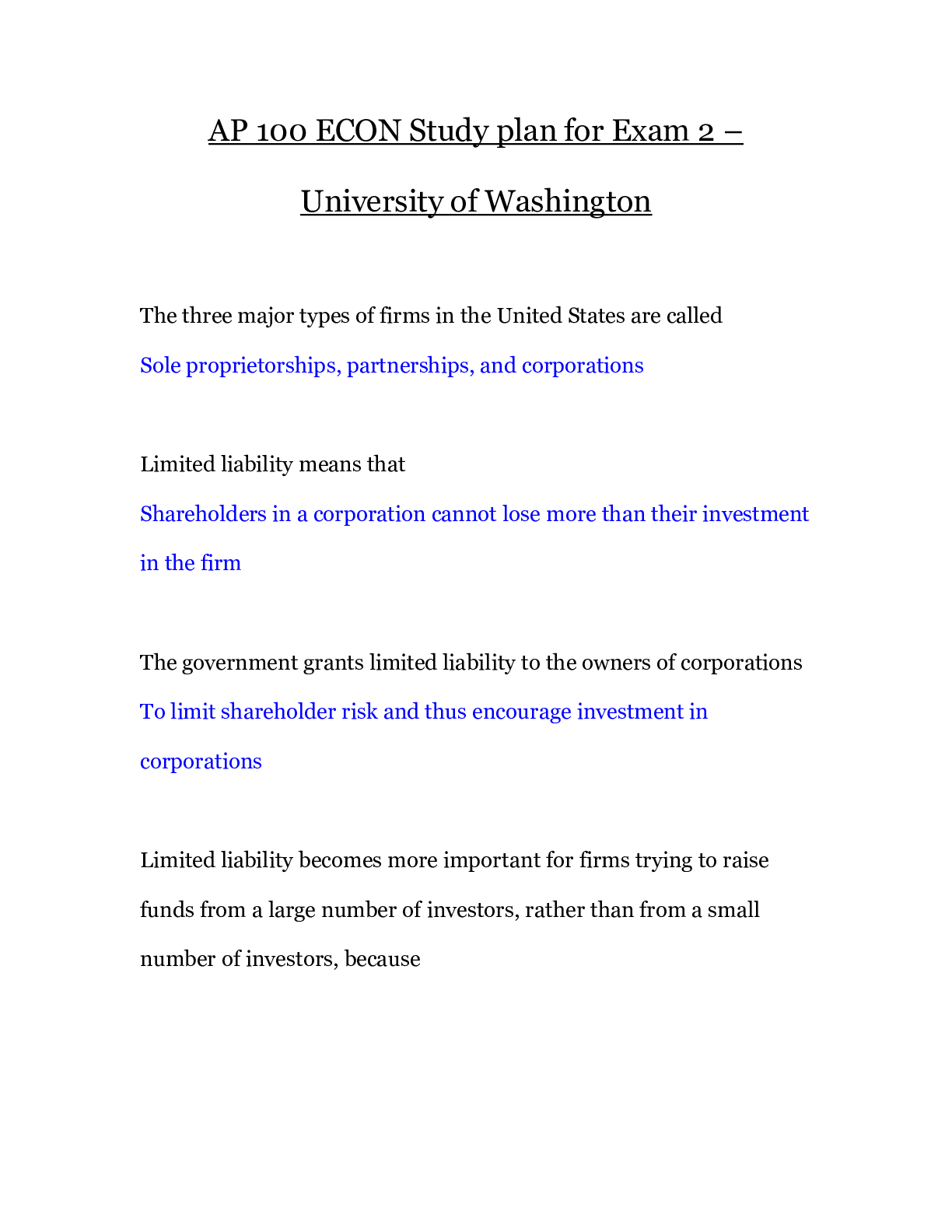
Buy this document to get the full access instantly
Instant Download Access after purchase
Add to cartInstant download
Reviews( 0 )
Document information
Connected school, study & course
About the document
Uploaded On
Oct 14, 2020
Number of pages
399
Written in
Additional information
This document has been written for:
Uploaded
Oct 14, 2020
Downloads
0
Views
51















